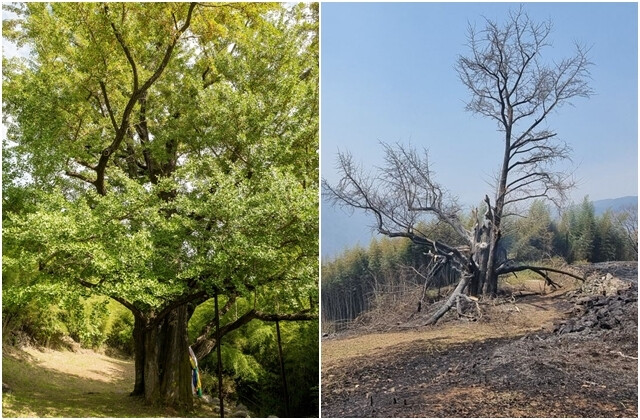
"Amidst the spreading damage from the large wildfires in Sancheong County and other areas, there are widespread expressions of regret as cultural heritages have also fallen victim to the flames.
As of the 24th, it has been reported that cultural monuments and temples have suffered damage, including the burning of a ginkgo tree in Okjong-myeon, Hadong County, the annex buildings of Dubangjae, and parts of Seonghwasa Temple in Sicheon-myeon, Sancheong County.
The 900-year-old ginkgo tree near Dubangjae in Duyang-ri, Okjong-myeon, Hadong County, was engulfed in flames on the morning of the 23rd. The fire severely damaged a significant portion of the ginkgo tree, breaking several thick branches. The middle section of the ginkgo tree turned black with clear signs of burning. The stately appearance of the 900-year-old ginkgo tree was lost in an instant.
This ginkgo tree is deeply regrettable because of its ecological and historical-cultural value.
Located 800m up a trail from Duyang Village, the ginkgo tree boasts a height of 27m and a circumference of 9.3m. It is said to have been planted by General Kang Min-cheom (963-1021), who served as a deputy general under General Kang Gam-chan during the Goryeo-Khitan War in 1018 and made significant contributions. Villagers have revered this ginkgo tree, which bears the traces of General Kang Min-cheom. It was designated as a Gyeongsangnam-do Monument in 1983 and has been under management. Nearby is Dubangjae, designated as Gyeongsangnam-do Cultural Heritage Material No. 81 in 1983, a shrine that enshrines the portrait of General Kang Min-cheom. Some annex buildings of Dubangjae were burned, but the main building was spared from the flames due to swift suppression.
With the news that the beautiful and stately appearance of the old ginkgo tree can no longer be seen, outcries of lament are pouring in from all over.
Jin Hong-gon (Sancheong), who has visited the ginkgo tree almost every year for nearly 10 years, expressed his regret, saying, 'I visited it every year with an acquaintance, fascinated by the figure and spirit of the ginkgo tree seen after passing through the bamboo forest. Hearing the news that the tree was burned, I felt pain in my heart as if my own body was burned.'
Choi Baek-rim, who returned to his hometown of Duyang Village a few years ago, expressed his deep affection for the ginkgo tree in a poem, making his sense of loss even greater. Choi said, 'Although the tree belongs to the Kang clan, it is a tree that nearby residents have revered and cherished as the pride and self-esteem of the village for generations. I introduced it to many acquaintances, and they were all amazed. The sense of loss is indescribable upon hearing the news of the fire damage.'
Park Jeong-gi, CEO of Gomsol Landscaping, who has been at the forefront of preserving old trees, pointed out, 'Looking at the photos, it seems that the edges and roots are alive, so it is not completely dead. However, since most of the trunk and branches are lost, the ornamental value is gone, and being biologically alive is not significant. It should be considered dead. When a wildfire occurs, they should check if there are trees to be preserved, such as rare species, and extinguish the fire, but it seems that there is no such manual.'
Seonghwasa Temple in Sincheon-ri, Sicheon-myeon, Sancheong County, was damaged by a wildfire on the 22nd. Seonghwasa Temple, located in a mountain valley, suffered damage to three wooden buildings, including the main hall, Seonbang, and Sanshingak, as well as auxiliary structures, and the surrounding mountains were also affected by the fire. Some buildings were reduced to ashes, making them unrecognizable, causing further regret."
[Copyright (c) Global Economic Times. All Rights Reserved.]



























